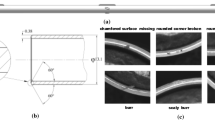Abstract
Neighboring pittings are one of the most frequently found defects in gas pipelines. Due to the interaction with each other, these defects accelerate the corrosion growth rates in the wall of the pipelines. So, it’s meaningful to discriminate multiple neighboring pittings from single pittings by analyzing their properties. However, accurate characterization of these defects is a challenging task because of the limited resolution of the current inspection methods. This paper presents a high-resolution optical inspection method and automated sizing algorithms for estimating the diameters and separation distances of the neighboring pittings. The proposed optical method consists of a three-axis scanner, a linear laser diode, a CCD camera, and a test specimen containing various patterns of neighboring pittings. C-scan images for the defined defect geometries are generated by extracting the intensity information of the reflected laser light captured using a CCD camera. Neighboring pittings can be differentiated and characterized using the obtained C-scan images. Experiments in a lab configuration have been conducted and satisfactory results have been achieved.









Similar content being viewed by others
REFERENCES
Afzal, M. and Udpa, S., Advanced signal processing of magnetic flux leakage data obtained from seamless gas pipeline, NDT&E Int., 2002, vol. 35, pp. 449–457.
Santamaria, W. and Bluck, M., Advancements in the detection and sizing of pinhole metal loss, in Proc. 2014 10th Int. Pipeline Conf., Calgary, Alberta, Canada, 2014.
Y. Gunaltun, Top of line corrosion in gas lines confirmed by condensation analysis, Oil Gas J., 1999, vol. 97, p. 28.
Singer, M., CO2 top of the line corrosion in presence of acetic acid: A parametric study, in Proc. NACE CORROSIO-N 2009, Atlanta, 2009.
Pugh, D.V., Top-of-line corrosion mechanism for sour wet gas pipelines, NACE CORROSION, 2009, paper no. 09285.
Macaw's Pipeline Defects. s.l.: Yellow Pencil Marketing, Argent, C., Ed., Pennwell Corp., 2005.
Ravan, M., Amineh, R.K., Koziel, S., Nikolova, N.K., and Reilly, J. P., Sizing of 3-D arbitrary defects using magnetic flux leakage measurements, IEEE Trans. Magn., 2010, vol. 46, pp. 1024–1033.
Davidson, R., An Introduction to Pipeline Pigging, Pigging Prod. Serv. Assoc., 2002.
Walker, J., In-line inspection of pipelines—advanced technologies for economic and safe operation of oil and gas pipelines, Rosen Group—Rosen Swiss Ag, 2010, no. 327.
Gunaltun, Y., Piccardino, R., and Vinazza, D., Interpretation of MFL and UT inspection results in case of top of line corrosion, NACE Corrosion Expo, 2006, NACE paper no. 06170.
Huyse, L., Roodselaar, A.V., Onderdonk, J., Wimolsukpirakul, B., Baker, J., Beuker, T., Palmer, J., and Jemari, N.A., Improvements in the accurate estimation of top of the line internal corrosion of subsea pipelines on the basis of in-line inspection data, in Proc. 8th Int. Pipeline Conf., Calgary, Alberta, Canada, 2010.
Cordell, J.L., In-line inspection: What technology is best?, Pipe Line Ind., 1991, vol. 47, p. 58.
Duran, O., Althoefer, K., and Seneviratne, L.D., State of the art in sensor technologies for sewer inspection, Sensors J., IEEE, 2002, vol. 2, pp. 73–81.
Ref Manuals & Reports Fd-6. Existing Sewer Evaluation and Rehabilitation.Vol. 62, Reston, VA: Am. Soc. Civ. Eng., 1994.
Kirkham, R., Kearney, P.D., Rogers, K.J., and Mashford, J., PIRAT: A system for quantitative sewer pipe assessment, Int. J. Robotics Res., 2000, vol. 19, pp. 1033–1053.
Dirksen, J., Clemens, F., Korving, H., Cherqui, F., Gauffre, P., Ertl, T., Plihal, H., Muller, K., and Snaterse, C., The consistency of visual sewer inspection data, Struct. Infrastruct. Eng., 2013, vol. 9, pp. 214–228.
Wirahadikusumah, R., Abraham, D.M., Iseley, T., and Prasanth, R.K., Assessment technologies for sewer system rehabilitation, Autom. Constr., 1998, vol. 7, pp. 259–270.
Olhoeft, G.R., Maximizing the information return from ground penetrating radar, J. Appl. Geophys., 2000, vol. 43, pp. 175–187.
Feng, Z., Horoshenkov, V., Tareq, M., and Tait, S., An acoustic method for condition classification in live sewer networks, in Proc. 18th World Conf. Nondestr. Test., Durban, South Africa, 2012.
Zhang, Z., A flexible new technique for camera calibration, IEEE Trans. Pattern Anal. Mach. Intell., 2000, vol. 22, pp. 1330–1334.
Wright, D., Greve, P., Fleischer, J., and Austin, L., Laser beam width, divergence and beam propagation factor—an international standardization approach, Opt. Quantum Electron., 1992, vol. 24, pp. 993–1000.
Gonzalez, R.C. and Wintz, P., Digital Image Processing, Reading, MA: Addison-Wesley, 1987.
Author information
Authors and Affiliations
Corresponding author
Rights and permissions
About this article
Cite this article
Azizzadeh, T., Safizadeh, M.S. Detection and Identification of Neighboring Pittings Using High-Resolution Optical Method. Russ J Nondestruct Test 56, 275–283 (2020). https://doi.org/10.1134/S106183092003002X
Received:
Revised:
Accepted:
Published:
Issue Date:
DOI: https://doi.org/10.1134/S106183092003002X




